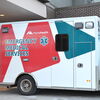Processing Your Payment
Please do not leave this page until complete. This can take a few moments.
Doing well at work | Wellness programs gain ground promoting employee health and reducing insurance costs
 Photo/Amber Waterman
Dr. Larry Catlett, founder of Occupational Medical Consulting in Leeds, developed a coaching program to promote wellness in the workplace based on an employee's desire to be healthy, rather than to save himself or the company money
Photo/Amber Waterman
Dr. Larry Catlett, founder of Occupational Medical Consulting in Leeds, developed a coaching program to promote wellness in the workplace based on an employee's desire to be healthy, rather than to save himself or the company money
Bill Findeisen has no control over the cost of an X-ray. Or surgery. Or any hospital service.
But in 2004, he figured just maybe he could control how many times his employees needed any of those services.
President of Dearborn Precision Tubular Products, a company in western Maine that makes parts for the aircraft, oil drilling and medical industries, Findeisen decided to invest in a health coach.
Four years into it, one-quarter of his employees who smoked had quit. One-third are exercising when they hadn’t been. Fewer are experiencing lower back pain.
And this year, for the first time in a long, long while, the cost of his health insurance with Harvard Pilgrim didn’t go up. In fact, it went down 4.9%.
“That was remarkable,” Findeisen says.
For Dearborn, the cost of a health coach is paying for itself in fewer doctors visits, and employees who are feeling and performing better at their jobs — all boons for the Fryeburg manufacturer. But Findeisen also sees broader implications.
“We’re having this national debate over health care and we’re going to have health care reform of a sort — that’s clear. My view is that this kind of program belongs as part of that discussion,” Findeisen says. “It’s great that we’re going to insure more people, but that doesn’t have anything to do with people’s health.”
It’s a concept that’s gaining momentum. Nationally, the Wellness Council of America counts 3,200-plus businesses and organization members. The number belonging to the Wellness Council of Maine has doubled in the last three years to more than 100.
Findeisen contracts for his health coach through Occupational Medical Consulting in Leeds, a company founded by Dr. Larry Catlett. Catlett says his technique revolves around “motivational interviewing” and getting buy-in from workers, not because being well would be better for their company, but because it would be better, specifically, for them.
“Instead of saying, ‘You’re killing yourself, dummy,’ which is what we’ve been saying for years, (it’s) ‘What do you think you can do?’” Catlett says.
Instead of a health coach offering stats on morbidity and disease, he says, how about saying, “‘We can, 70% of the time, keep you deer hunting as long as you want’ — that’s a whole different issue.”
Catlett has thousands of Maine employees on his program. One of his newest clients is Portland-based Barber Foods, a contract that prompted him to hire his first Spanish-language coach. Staff and faculty at four Maine schools are part of a pilot program. Other companies lease his program software for themselves. MaineGeneral Health uses it to work with Augusta-area businesses. Out-of-state companies are using it to teach health and wellness at work to coal miners in Wyoming and the Green Bay Packers’ office staff in Wisconsin.
“In general, people are becoming aware that prevention is important,” Catlett says. “We are what we eat and don’t do — people are now realizing that.”
‘A healthier atmosphere’
Jaime Laliberte, director of the Wellness Council of Maine, works with 115 member businesses and organizations from Presque Isle to Portland. The nonprofit council got its start at the Bangor Region Chamber of Commerce; it went statewide two years ago.
Designed for those eager to promote wellness within the workplace but unsure of where to start, it offers advice and a website of resources.
The draw for most companies?
“It’s the bottom line, for sure,” says Laliberte. “Certainly, with the skyrocketing health care costs, that’s the biggest driver.”
For many companies, there is a payoff — “I’ve seen ROI as high as $8 to every $1 invested” — but results take time, she says.
“I do have [human resource directors] who think if they give me a check for $365 everything will magically be better the next year,” Laliberte says of the annual fee to belong to the wellness council.
Laliberte has seen companies start walking programs; highlight healthy choices in vending machines; educate employees on their health insurance plan benefits (for instance, did they realize it covers an annual physical?); and talk about when to take a trip to the emergency room versus making a regular doctor’s appointment.
All are points that get at health and at cost, she says.
Leslie Bickford is program manager of Take Charge! at the Maine Heart Center in Portland, a program originating out of St. Mary’s Regional Medical Center in Lewiston, that visits work sites to screen for cholesterol, blood pressure and body mass index. The program has screened more than 4,000 people since 2005. In follow-up surveys, 30% to 40% of participants report making some sort of diet or exercise change as a result of the screening, she says. Ninety percent of those encouraged to see their doctor for a follow-up visit do so.
“Employers just want to try to create a healthier atmosphere,” Bickford says, although she notes some clients opted out of the wellness program as the economy soured.
Three years ago, Anthem Blue Cross and Blue Shield rolled out a 2% wellness discount to businesses with 25 to 50 employees as part of Chamber BlueOptions insurance plans offered through the Maine State Chamber of Commerce. Now open to businesses with between 15 and 50 employees, that discount is 3% off the next year’s premium.
Companies earn the discount by having employees earn points toward a benchmark goal. Taking a health risk assessment is 1,200 points, logging exercise online is 25 points per log. If a business earns an average of 2,500 points per employee, it gets the discount. Don Antonucci, sales director at Anthem, says only one company has earned the discount so far, Wooden Boat Publications out of Brooklin, which has earned the distinction for two years in a row. He’s aware of five or so companies trying for it in 2010.
For smaller companies, “you can’t really affect your rate except if you pick different (insurance) products,” Antonucci says. The wellness discount is one way to take some control. “Three percent can add up to several thousand dollars,” he says. Without results yet in hand, Anthem is hoping companies that make the effort to earn the discount will ultimately be healthier, seeing fewer claims, he says.
Counting the savings
Catlett’s program got its start while he worked for Cianbro Corp. in Pittsfield as its medical director in the 1990s. The large construction company made the decision to be proactive, he says, in part because projections by Cianbro’s health insurer showed that if premiums kept climbing at the existing pace, by 2013 or 2014 “every dime in profit was going to be spent on medical care.”
A small, six-month trial with 100 workers showed early promise. Seventy employees labeled high risk because of factors like high blood pressure and cholesterol, smoking or being overweight showed marked improvement. But rolling the program out companywide, and being less hands-on, didn’t work, Catlett says. The coach approach was born.
In 2007, after moving a bulk of employees from either high risk to medium risk, or from medium risk to low, Cianbro could look at its books and count how being proactive paid.
According to Catlett, the company spent an average $3,757 on health care for each low-risk employee.
It spent more than twice that, $9,223 on average, for each employee labeled high risk.
And in 2008, instead of spending roughly $21 million on health care costs — the amount projected — it spent closer to $13 million.
Catlett says his program, which costs companies about $200 per employee, per year, encourages small, realistic goals. For instance, he says, instead of quitting cold turkey on an ice cream habit, try one bowl every other night. The program pays attention to the “seriously well,” who he says run the risk of losing their healthy status at the rate of about 3% every three years because of complacency. And it pays attention to employees’ time outside work. Coaches are open to talking about home life and other stressors.
“Why do people stick their fingers in machines? Because they’re thinking about something else,” Catlett says. “You have to have (a life-work balance) as part of a wellness program.”
Findeisen said only 1% or 2% of his 230 employees have opted out of Dearborn’s wellness program. Initially, employees were given the incentive of saving 15% of their out-of-pocket family health insurance premiums.
“After about the third year, we ratcheted that up a bit where they have to meet some benchmark in four of the five (risk) categories,” he says. “Everybody does.”
Some of his employees have formed a cycling group after work. Some get together for hikes or walks at lunch. In the winter, for fun, there are snowshoe races in the courtyard.
The Jackson Laboratory in Bar Harbor is hoping for similar results.
A wellness council member, Jackson Lab changed its health and wellness program this year. Instead of offering its 1,300 employees money to take part in tele-coaching with a nurse or filling out a risk assessment, it’s charging a deductible for its health insurance for the first time, and offering healthy ways for employees to work that deductible back to zero.
“One main driver is trying to help stave down health insurance premiums,” says Ben Billings, Jackson’s wellness program coordinator.
Though self-insured, Billings says Jackson Lab worked with Aetna to design the program.
“I can’t speak to the return yet. Hopefully what we put in place this year will definitely help pay for itself,” he says.
Kathryn Skelton, a writer based in Litchfield, can be reached at editorial@mainebiz.biz.
CASE STUDY
Dearborn Precision Tubular Products Inc., Fryeburg
Wellness program results *
No. employees Oct. 2004, Oct. 2008
Low risk: 14, 75
Medium risk: 70, 66
High risk: 79, 22
Poor nutrition: dropped 76.5%
Tobacco smoking: dropped 23.5%
Reports of lower back pain: dropped 77.8%
No seatbelt/helmet use: dropped 38.5%
Total high cholesterol: dropped 9.8%
* Risk measures factors like cholesterol, blood pressure, body mass index, smoking and physical activity









Comments